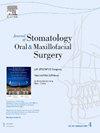Clinicopathological and prognostic significance of indoleamine 2,3-dioxygenase (IDO) expression in head and neck squamous cell carcinoma: A systematic review and meta-analysis
IF 1.8
3区 医学
Q2 DENTISTRY, ORAL SURGERY & MEDICINE
Journal of Stomatology Oral and Maxillofacial Surgery
Pub Date : 2024-10-29
DOI:10.1016/j.jormas.2024.102130
引用次数: 0
Abstract
Objective
Indoleamine 2,3-dioxygenase-1 (IDO1) is a promising antitumor target and predictive biomarker in a variety of cancers. Hence, we performed this meta-analysis to evaluate the clinicopathological and prognostic significance of IDO1 in head and neck squamous cell carcinoma (HNSCC).
Methods
We searched PubMed, Embase, Web of Science and Scopus databases from inception to May 2024, to identify studies measuring the clinicopathological and prognostic significance of IDO1 in HNSCC. The role of IDO1 in HNSCC was evaluated by pooled hazard ratios (HR), odd ratios (OR) and 95% confidence intervals (CI). The meta-analysis was performed using the meta package in R. Omics analyses on IDO1 were also performed.
Results
Ten studies (1,119 participants) were included in the review. The analysis showed an insignificant relationship between IDO1 expression and poor overall survival, and progression free survival as indicated by the pooled HR (HR: 1.65, 95% CI: 0.68–4.02), (HR: 1.73, 95% CI: 0.63–4.77), respectively. Additionally, elevated expression of IDO1 was significantly associated with tumor T stage (OR: 1.44, 95% CI: 1.06–1.94). However, it was insignificantly correlated with positive lymph node metastasis (N status) (OR: 1.11; 95% CI: 0.82–1.50) and tumor-node-metastasis (TNM) stage (OR: 1.14; 95% CI: 0.79–1.64).
Conclusion
While higher IDO1 expression is associated with the risk of advanced tumor stage in HNSCC, its impact on overall and progression-free survival remains inconclusive. Further research is needed to elucidate its prognostic significance and therapeutic potential.
头颈部鳞状细胞癌中吲哚胺 2,3-二氧化酶 (IDO) 表达的临床病理和预后意义:系统综述和元分析。
研究目的吲哚胺-2,3-二氧合酶-1(IDO1)是一种很有前景的抗肿瘤靶点,也是多种癌症的预测性生物标志物。因此,我们进行了这项荟萃分析,以评估 IDO1 在头颈部鳞状细胞癌(HNSCC)中的临床病理和预后意义:方法:我们检索了PubMed、Embase、Web of Science和Scopus数据库中从开始到2024年5月有关IDO1在HNSCC中的临床病理学和预后意义的研究。IDO1在HNSCC中的作用通过汇总的危险比(HR)、奇数比(OR)和95%置信区间(CI)进行评估。荟萃分析使用 R 中的 meta 软件包进行,还对 IDO1 进行了 Omics 分析:10项研究(1,119名参与者)被纳入综述。分析结果显示,IDO1表达与总生存期和无进展生存期之间的关系并不显著,汇总HR分别为(HR:1.65,95% CI:0.68-4.02)和(HR:1.73,95% CI:0.63-4.77)。此外,IDO1表达的升高与肿瘤T分期显著相关(OR:1.44,95% CI:1.06-1.94)。然而,它与淋巴结转移(N 状态)阳性(OR:1.11;95% CI:0.82-1.50)和肿瘤-结节-转移(TNM)分期(OR:1.14;95% CI:0.79-1.64)的相关性不明显:结论:虽然IDO1的高表达与HNSCC的肿瘤晚期风险有关,但其对总生存期和无进展生存期的影响仍不确定。结论:虽然 IDO1 表达较高与 HNSCC 肿瘤晚期风险有关,但其对总生存期和无进展生存期的影响仍无定论,需要进一步研究以阐明其预后意义和治疗潜力。
本文章由计算机程序翻译,如有差异,请以英文原文为准。
求助全文
约1分钟内获得全文
求助全文
来源期刊

Journal of Stomatology Oral and Maxillofacial Surgery
Surgery, Dentistry, Oral Surgery and Medicine, Otorhinolaryngology and Facial Plastic Surgery
CiteScore
2.30
自引率
9.10%
发文量
0
审稿时长
23 days
 求助内容:
求助内容: 应助结果提醒方式:
应助结果提醒方式:


